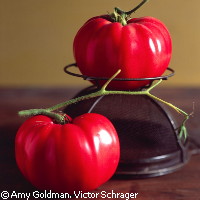Giant icebox keeping world's seeds safe
Heightened concerns about food security have propelled an international group of experts to grow and maintain important collections of diverse crops in the Svalbard 'Doomsday' Global Seed Vault, a seed bank located in Norway. Their objective is to thwart any food shortages that could lead to crop diversity loss and ultimately a breakdown in global food production. Founded by the United Nations Food and Agriculture Organisation (FAO) and the research institute Bioversity International, the Italian-based Global Crop Diversity Trust created the gigantic vault located in the Norwegian archipelago of Svalbard. The Trust has reported that the addition of new deposits in the vault brings the number of seed varieties to more than 500,000. 'Reaching the half million mark brings mixed emotions, because while it shows that the vault at Svalbard is now the gold standard for diversity, it comes at a time when our agriculture systems are really sitting on a knife's edge,' explained Dr Cary Fowler, the Trust's executive director. Storage capacity of the vault stands at 4.5 million seeds. Nestled in Svalbard's Plataberget Mountain, the vault's location is a key factor because the area's permafrost helps maintain preservation of the seed deposits, and tectonic activity is low as well. The vault's repository contains seeds from around the world, including a hardy German pink tomato, a rare variety transported to the US state of Iowa in 1883 by a Bavarian immigrant. This man was the grandfather of one of the co-founders of the Seed Savers Exchange, a non-profit organisation that saves and shares rare garden species. The US-based Seed Savers Exchange has shipped more than 400 samples to the vault. Also housed inside the vault is a highly valuable strawberry species obtained from the flanks of the Atsonupuri volcano in the southern Kuril Islands of Russia, just 150 kilometres northeast of Hokkaido, Japan, as well as a wild bean from South America. This bean, called Phaseolus costaricensis, seems to be able to resist white mould, a disease that significantly threatens common domesticated bean varieties that are a major part of the South American diet. 'The mould-resistant bean is particularly important because it shows why we need to collect and conserve not just domestic crops but also their wild relatives,' commented Dr Daniel Debouck, head of the Genetic Resources Unit at the International Center for Tropical Agriculture (CIAT) in Colombia, which has shipped 3,837 crop varieties from 75 nations to the Norwegian vault. The wide range of crops that are now under protection in Norway, along with other global seed repositories, 'are keys to climate change adaption for the world's farmers,' said Dr Fowler, who was a professor at the Norwegian University of Life Sciences. Latest studies on crops and agriculture hint that maize production in Africa, for example, could be reduced by 25% or more by 2030. If this is the case, Africa would face destabilisation and in turn trigger a food crisis worldwide. Experts believe plant breeders must develop new heat- and drought-resistant varieties without delay. 'If crops and agriculture don't adapt to climate change, neither will humanity,' Dr Fowler cautioned. 'But to help farmers adapt, plant breeders need access to as much genetic diversity as possible to keep crops vigorous and productive in shifting climates.' For his part, Dr Debouck said: 'Plant breeders already are hard at work, exploring whether the wild bean can be crossed with domesticated bean varieties and thus avoid what could be a troubling interruption to food production.' In conclusion, Dr Fowler said: 'Svalbard is a fail-safe backup to be used whenever a depositing seed bank loses part of or all of its collection, but we should focus equally on averting the disasters in the first place. Crop gene banks are our first and best line of defence, yet something as mundane as a poorly functioning freezer could ruin a collection that 10 years from now could be critical to averting a food crisis.' The Global Crop Diversity Trust is collaborating with the Norwegian government, and the Swedish-based Nordic Genetic Resource Center is running the vault, whose construction cost more than EUR 6 million.
Countries
Colombia, Germany, Italy, Norway, Russia



